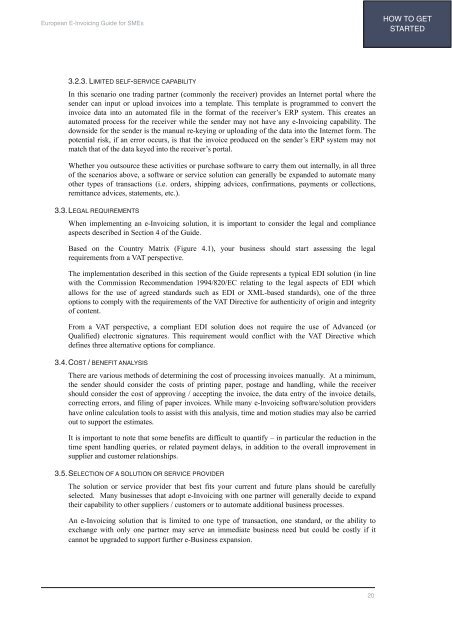Download the European e-Invoicing Guide for SMEs - Celeris Ltd.
Download the European e-Invoicing Guide for SMEs - Celeris Ltd.
Download the European e-Invoicing Guide for SMEs - Celeris Ltd.
You also want an ePaper? Increase the reach of your titles
YUMPU automatically turns print PDFs into web optimized ePapers that Google loves.
<strong>European</strong> E-<strong>Invoicing</strong> <strong>Guide</strong> <strong>for</strong> <strong>SMEs</strong><br />
3.2.3. LIMITED SELF-SERVICE CAPABILITY<br />
In this scenario one trading partner (commonly <strong>the</strong> receiver) provides an Internet portal where <strong>the</strong><br />
sender can input or upload invoices into a template. This template is programmed to convert <strong>the</strong><br />
invoice data into an automated file in <strong>the</strong> <strong>for</strong>mat of <strong>the</strong> receiver’s ERP system. This creates an<br />
automated process <strong>for</strong> <strong>the</strong> receiver while <strong>the</strong> sender may not have any e-<strong>Invoicing</strong> capability. The<br />
downside <strong>for</strong> <strong>the</strong> sender is <strong>the</strong> manual re-keying or uploading of <strong>the</strong> data into <strong>the</strong> Internet <strong>for</strong>m. The<br />
potential risk, if an error occurs, is that <strong>the</strong> invoice produced on <strong>the</strong> sender’s ERP system may not<br />
match that of <strong>the</strong> data keyed into <strong>the</strong> receiver’s portal.<br />
Whe<strong>the</strong>r you outsource <strong>the</strong>se activities or purchase software to carry <strong>the</strong>m out internally, in all three<br />
of <strong>the</strong> scenarios above, a software or service solution can generally be expanded to automate many<br />
o<strong>the</strong>r types of transactions (i.e. orders, shipping advices, confirmations, payments or collections,<br />
remittance advices, statements, etc.).<br />
3.3.LEGAL REQUIREMENTS<br />
When implementing an e-<strong>Invoicing</strong> solution, it is important to consider <strong>the</strong> legal and compliance<br />
aspects described in Section 4 of <strong>the</strong> <strong>Guide</strong>.<br />
Based on <strong>the</strong> Country Matrix (Figure 4.1), your business should start assessing <strong>the</strong> legal<br />
requirements from a VAT perspective.<br />
The implementation described in this section of <strong>the</strong> <strong>Guide</strong> represents a typical EDI solution (in line<br />
with <strong>the</strong> Commission Recommendation 1994/820/EC relating to <strong>the</strong> legal aspects of EDI which<br />
allows <strong>for</strong> <strong>the</strong> use of agreed standards such as EDI or XML-based standards), one of <strong>the</strong> three<br />
options to comply with <strong>the</strong> requirements of <strong>the</strong> VAT Directive <strong>for</strong> au<strong>the</strong>nticity of origin and integrity<br />
of content.<br />
From a VAT perspective, a compliant EDI solution does not require <strong>the</strong> use of Advanced (or<br />
Qualified) electronic signatures. This requirement would conflict with <strong>the</strong> VAT Directive which<br />
defines three alternative options <strong>for</strong> compliance.<br />
3.4.COST / BENEFIT ANALYSIS<br />
There are various methods of determining <strong>the</strong> cost of processing invoices manually. At a minimum,<br />
<strong>the</strong> sender should consider <strong>the</strong> costs of printing paper, postage and handling, while <strong>the</strong> receiver<br />
should consider <strong>the</strong> cost of approving / accepting <strong>the</strong> invoice, <strong>the</strong> data entry of <strong>the</strong> invoice details,<br />
correcting errors, and filing of paper invoices. While many e-<strong>Invoicing</strong> software/solution providers<br />
have online calculation tools to assist with this analysis, time and motion studies may also be carried<br />
out to support <strong>the</strong> estimates.<br />
It is important to note that some benefits are difficult to quantify – in particular <strong>the</strong> reduction in <strong>the</strong><br />
time spent handling queries, or related payment delays, in addition to <strong>the</strong> overall improvement in<br />
supplier and customer relationships.<br />
3.5.SELECTION OF A SOLUTION OR SERVICE PROVIDER<br />
The solution or service provider that best fits your current and future plans should be carefully<br />
selected. Many businesses that adopt e-<strong>Invoicing</strong> with one partner will generally decide to expand<br />
<strong>the</strong>ir capability to o<strong>the</strong>r suppliers / customers or to automate additional business processes.<br />
An e-<strong>Invoicing</strong> solution that is limited to one type of transaction, one standard, or <strong>the</strong> ability to<br />
exchange with only one partner may serve an immediate business need but could be costly if it<br />
cannot be upgraded to support fur<strong>the</strong>r e-Business expansion.<br />
20<br />
HOW TO GET<br />
STARTED


